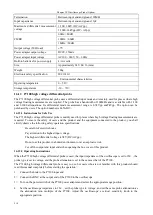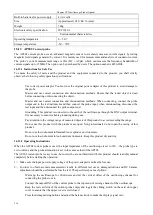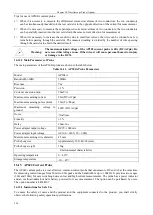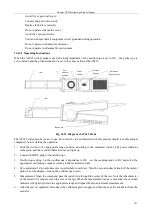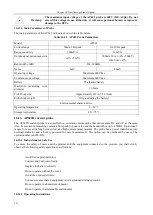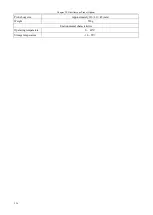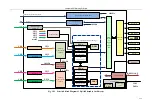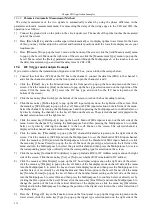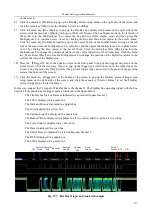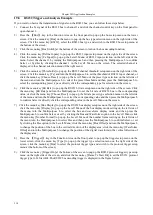
Chapter XVIOscilloscope Probe (Option)
225
Jaw
Jaw
switch
Range
switching
Output
end
Fig. 16.34 Diagram Accessories of AP621 Probe
The AP621 current probe is easy to use, but users who are not familiar with this product should read this manual
completely before starting the operation:
1
)
Push the switch to the appropriate range position according to the measured current.
2
)
Connect the BNC plug to the oscilloscope.
3
)
Oscilloscope setting: Set the oscilloscope
’
s impedance to 1M
Ω
, set the coupling mode to DC, and select the
appropriate oscilloscope range according to the measured current.
4
)
Measurement: Open the clamp and pass the tested wire through the center of the jaw. Note that the diameter
of the tested wire cannot exceed the size of the jaw.
5
)
After the test is completed, take out the conductor from the card slot.
Warning:
The maximum input voltage of the AP621 probe is 2000V (DC+ACpk). Do not
exceed this voltage in use. Otherwise, it will cause personal hazard or injury or
damage to the DUTs.
16.17.3 Main Parameters of Probe
The main parameters of the AP621 probe are shown in the table below.
Table 16.17 AP621 Probe Parameters
Model
AP621
Range sensitivity
100mV/A
10mV/A
1mV/A
Current range
0.1A-20A peak
1A-200A peak
10A-2000A peak
Output error
3%+10mV
2%+5mV
1%+1mV
Bandwidth
10Hz to 100kHz
Maximum
operating
voltage
600Vrms
Maximum
common
mode voltage
600V CATIII
Maximum
measuring
wire diameter
53mm
Summary of Contents for 4456 Series
Page 10: ...VIII...
Page 55: ...Chapter V Trigger System 45 Fig 5 51 RF Test Signal Example...
Page 69: ...Chapter VII Mathematical Operation 59 Fig 7 10 Advanced Math Example...
Page 71: ...Chapter VIII Display System 61 Fig 8 3 Wfm Palette Menu Fig 8 4 Normal Palette...
Page 72: ...Chapter VIII Display System 62 Fig 8 5 Inverted Palette Fig 8 6 Temperature Palette...
Page 75: ...Chapter VIII Display System 65 Fig 8 12 XY Display Example...
Page 165: ...Chapter XI Protocol Analyzer Option 155 Fig 11 242 1553 Trigger and Analysis Example...




